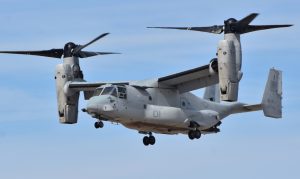Takahashi Kosuke

The Bell-Boeing V-22 Osprey tilt-rotor aircraft is raising renewed concerns – and even protests – over its safety in Okinawa and elsewhere in Japan. This week, the U.S. military decided to ground its fleet of the transport aircraft following the fatal crash off southwest Japan of a CV-22 Osprey flying from Yokota Air Base in Tokyo, which killed eight crew members on board.
Although the Osprey has a long history of accidents, the latest deadly crash in Japan became the second-worst accident ever worldwide. The worst accident involving an Osprey occurred on April 8, 2000, when 19 Marines died during an operational test at Marana Regional Airport in the U.S. state of Arizona.
On December 7, U.S. Pentagon Deputy press spokesperson Sabrina Singh said that the decision to stand down all of the Ospreys flown by the U.S. Marine Corps, Air Force, and Navy was “taken out of an abundance of caution” while the Air Force Special Operations Command (AFSOC) conducts an investigation.
The Osprey “is versatile, and its speed and its vertical lift capabilities are not met by any other platform existing in fixed or rotary-wing platforms, and so it’s an incredibly useful platform for all of our Services to use,” Singh said.
However, no matter what the Pentagon says, there have been 20 deaths in four crashes over the past 20 months. That inevitably raises one simple question: Is the Osprey really safe?
According to the latest data from the Air Force Safety Center, the average Class A mishap rate per 100,000 flight hours was 6.00 for the CV-22 in its lifetime as of December 2021. This accident rate is extremely high compared to the U.S. Air Force’s overall mishap rate of 1.35 for manned aircraft and 2.58 for unmanned aircraft as of September 2023.
Furthermore, both Class A and Class B accidents for the CV-22 are actually on a rising trend line over the past 20 years, according to the Air Force Safety Center data.
Class A mishaps occur when there is more than $2.5 million in damage to the aircraft, the aircraft is destroyed, or its pilot or crewmember is killed or permanently, totally disabled. By contrast, Class B mishaps occur when aircraft damage ranges from $600,000 to $2.5 million, a crewmember faces permanent partial disability, or three or more persons are sent to the hospital due to the accident.
Currently, the U.S. Air Force has 51 CV-22s. Meanwhile, the U.S. Marine Corps has some 400 MV-22s. The U.S. Navy has 27 CMV-22s.
The website of the U.S. Marine Corps in Okinawa introducing the MV-22 Osprey states that “The MV-22 is safe: it has a Class A mishap rate of 3.27 per 100,000 flight hours since FY2010, on par with other Marine Corps aviation platforms.”
In addition, according to an accident report published in July 2023 after an MV-22 crashed into the California desert in June 2022, killing five crew members, the 10-year average mishap rate for the MV-22 is 3.16 per 100,000 flight hours. This is indeed on par with the USMC aviation mishap average of 3.1, which includes aircraft such as the AV-8B, F/A-18A-C, F-35B, CH-53E, and KC-130J. This also means that the MV-22 doesn’t have a safety record that is better than USMC averages.
According to Flightfax, an online magazine on aviation safety published by the U.S. Army Combat Readiness Center, the overall Army manned aircraft Class A rate was 1.62 in the current fiscal year, much lower than MV-22’s and CV-22’s mishap rates. (The U.S. Army does not use the Osprey at all.)
The fact that the V-22 is an expensive aircraft that is grounded often is a major reason why it still has few peers today, although it was a revolutionary capability when it first flew in 1989. The Osprey is an expensive capability that has found few buyers abroad – outside the United States, only the Japan Ground Self-Defense Force (JGSDF) decided to procure 17 V-22s. Meanwhile, others that have shown interest – such as Australia, Indonesia, and Israel – ultimately gave up on buying it.
On December 6, the AFSOC commander said in a statement that preliminary investigation information on the crashed CV-22 off Japan indicated a potential materiel failure caused the mishap.
How long Ospreys will be grounded around the world will depend on the results of the AFSOC’s ongoing investigation into the cause of the accident. If a structural problem with the aircraft – such as a sprag clutch failure or a failure of the drive shaft that links the Osprey’s two engines by running inside the length of the wings – is found as a cause of the fatal crash, there is a possibility that flights will be suspended for an extended period of time.
No comments:
Post a Comment